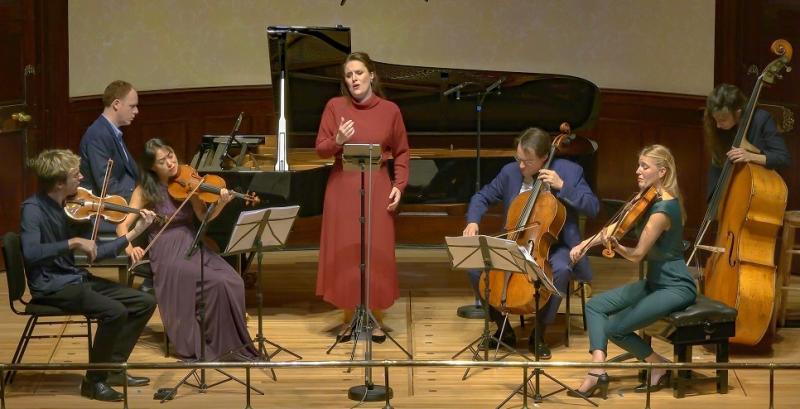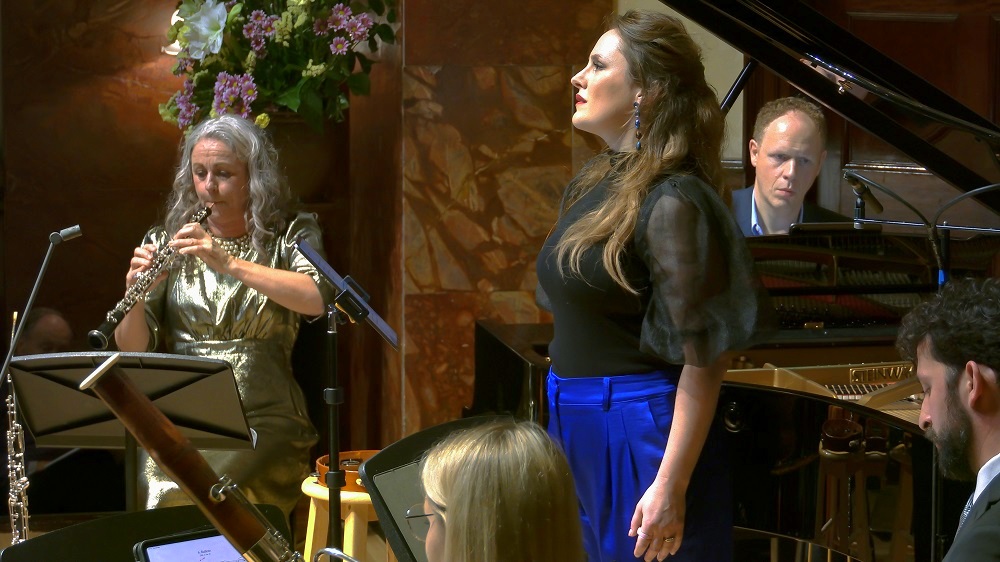Louise Alder & Friends, Wigmore Hall review - magic carpet rides with soprano, strings and woodwind | reviews, news & interviews
Louise Alder & Friends, Wigmore Hall review - magic carpet rides with soprano, strings and woodwind
Louise Alder & Friends, Wigmore Hall review - magic carpet rides with soprano, strings and woodwind
Levitational joy in an all-French programme, with modified rapture over two arrangements

Sometimes all the stars align in musical performance. There’s no soprano more alive to the expression of musical joy and rapture than Louise Alder, no composer more levitational in his strange later adventures than Fauré, no instrumentalists strings better than pianist Joseph Middleton, the Doric String Quartet and double-bass player Laurène Durantel at being supernatural companions throughout his song-cycle La bonne chanson.
Fauré's other miracles among his chamber works turn up with comparative regularity in concert, but for some reason I've not experienced his nine-song tribute to Paul Verlaine live before. So from first vioinist Tim Crawford's magical first sigh through to the final setting of "cette fantaisie et cette raison" it was a case of rising above the ground and never quite touching it, even if the composer's endless modulations and strange excursions sometimes came to rest. Spellbound to the point of unconsciously abandoning my critical faculties when it came to details, I can only note the perfection especially with which each song was rounded off ("La lune blanche" especially with its famous conclusion "C'est l'heure exquise").  Effervescent in presentation as always, Alder told us that what felt like ages of pregnancy had addled her brain and made her programme a very short first half. We weren't complaining, but there was sheer delight, too, in what she'd added, Berlioz's "La Captive" for soprano, cello (John Myerscough of the Dorics) and piano. There could have been five more verses, so captivating were the refrains especially, where Alder showed no weakness in the lower register of a totally connected voice.
Effervescent in presentation as always, Alder told us that what felt like ages of pregnancy had addled her brain and made her programme a very short first half. We weren't complaining, but there was sheer delight, too, in what she'd added, Berlioz's "La Captive" for soprano, cello (John Myerscough of the Dorics) and piano. There could have been five more verses, so captivating were the refrains especially, where Alder showed no weakness in the lower register of a totally connected voice.
The second half had a flaw not apparent in prospect. George Strivens had arranged both Ravel's Shéhérazade and a selection of Canteloube's Songs of the Auvergne for wind quintet alongside piano (pictured below, Amina Hussain, Rachael Clegg, Middleton, Alder, Max Welford, Guylaine Eckersley and Mark Alder Bennett). It may be the Wigmore's far from perfect acoustics amplified the woodwinds' middle registers, but they offered too much competition for the full-voiced soprano, who nevertheless provided the full frisson on the climax of "Asie" for the word "haine" (hate).  I can't help feeling Ravel's oriental rhapsodies would have worked better with the crucial flute/piccolo and oboe/cor anglais alongside two or three strings to set cushions on this particular flying carpet. Flautist Amina Hussain, wearing orange shalvar trousers to complement Alder's blue silk, was a true partner in "La flûte enchantée", and later Rahcel Clegg on cor anglais and clarinettist Max Welfordcame to the fore as rustic voices in the Canteloube. There were plenty of opportunities for the wind to shine here, and Middleton managed to make the tinkling ivories of "Baïlèro" truly dreamy. Another instrument joined the fray for the several more earthy numbers - the tambourine, of which Alder proved to be an accomplished as well as an exuberant exponent.
I can't help feeling Ravel's oriental rhapsodies would have worked better with the crucial flute/piccolo and oboe/cor anglais alongside two or three strings to set cushions on this particular flying carpet. Flautist Amina Hussain, wearing orange shalvar trousers to complement Alder's blue silk, was a true partner in "La flûte enchantée", and later Rahcel Clegg on cor anglais and clarinettist Max Welfordcame to the fore as rustic voices in the Canteloube. There were plenty of opportunities for the wind to shine here, and Middleton managed to make the tinkling ivories of "Baïlèro" truly dreamy. Another instrument joined the fray for the several more earthy numbers - the tambourine, of which Alder proved to be an accomplished as well as an exuberant exponent.
rating
Share this article
The future of Arts Journalism
You can stop theartsdesk.com closing!
We urgently need financing to survive. Our fundraising drive has thus far raised £49,000 but we need to reach £100,000 or we will be forced to close. Please contribute here: https://gofund.me/c3f6033d
And if you can forward this information to anyone who might assist, we’d be grateful.

Subscribe to theartsdesk.com
Thank you for continuing to read our work on theartsdesk.com. For unlimited access to every article in its entirety, including our archive of more than 15,000 pieces, we're asking for £5 per month or £40 per year. We feel it's a very good deal, and hope you do too.
To take a subscription now simply click here.
And if you're looking for that extra gift for a friend or family member, why not treat them to a theartsdesk.com gift subscription?
more Classical music
 Hallé John Adams festival, Bridgewater Hall / RNCM, Manchester review - standing ovations for today's music
From 1980 to 2025 with the West Coast’s pied piper and his eager following
Hallé John Adams festival, Bridgewater Hall / RNCM, Manchester review - standing ovations for today's music
From 1980 to 2025 with the West Coast’s pied piper and his eager following
 Kaploukhii, Greenwich Chamber Orchestra, Cutts, St James's Piccadilly review - promising young pianist
A robust and assertive Beethoven concerto suggests a player to follow
Kaploukhii, Greenwich Chamber Orchestra, Cutts, St James's Piccadilly review - promising young pianist
A robust and assertive Beethoven concerto suggests a player to follow
 Robin Holloway: Music's Odyssey review - lessons in composition
Broad and idiosyncratic survey of classical music is insightful but slightly indigestible
Robin Holloway: Music's Odyssey review - lessons in composition
Broad and idiosyncratic survey of classical music is insightful but slightly indigestible
 Classical CDs: Wolf-pelts, clowns and social realism
British ballet scores, 19th century cello works and contemporary piano etudes
Classical CDs: Wolf-pelts, clowns and social realism
British ballet scores, 19th century cello works and contemporary piano etudes
 Bizet in 150th anniversary year: rich and rare French offerings from Palazzetto Bru Zane
Specialists in French romantic music unveil a treasure trove both live and on disc
Bizet in 150th anniversary year: rich and rare French offerings from Palazzetto Bru Zane
Specialists in French romantic music unveil a treasure trove both live and on disc
 Scottish Chamber Orchestra, Ibragimova, Queen’s Hall, Edinburgh review - rarities, novelties and drumrolls
A pity the SCO didn't pick a better showcase for a shining guest artist
Scottish Chamber Orchestra, Ibragimova, Queen’s Hall, Edinburgh review - rarities, novelties and drumrolls
A pity the SCO didn't pick a better showcase for a shining guest artist
 Kilsby, Parkes, Sinfonia of London, Wilson, Barbican review - string things zing and sing in expert hands
British masterpieces for strings plus other-worldly tenor and horn - and a muscular rarity
Kilsby, Parkes, Sinfonia of London, Wilson, Barbican review - string things zing and sing in expert hands
British masterpieces for strings plus other-worldly tenor and horn - and a muscular rarity
 From Historical to Hip-Hop, Classically Black Music Festival, Kings Place review - a cluster of impressive stars for the future
From quasi-Mozartian elegance to the gritty humour of a kitchen inspection
From Historical to Hip-Hop, Classically Black Music Festival, Kings Place review - a cluster of impressive stars for the future
From quasi-Mozartian elegance to the gritty humour of a kitchen inspection
 Shibe, LSO, Adès, Barbican review - gaudy and glorious new music alongside serene Sibelius
Adès’s passion makes persuasive case for the music he loves, both new and old
Shibe, LSO, Adès, Barbican review - gaudy and glorious new music alongside serene Sibelius
Adès’s passion makes persuasive case for the music he loves, both new and old
 Anja Mittermüller, Richard Fu, Wigmore Hall review - a glorious hall debut
The Austrian mezzo shines - at the age of 22
Anja Mittermüller, Richard Fu, Wigmore Hall review - a glorious hall debut
The Austrian mezzo shines - at the age of 22
 First Person: clarinettist Oliver Pashley on the new horizons of The Hermes Experiment's latest album
Compositions by members of this unusual quartet feature for the first time
First Person: clarinettist Oliver Pashley on the new horizons of The Hermes Experiment's latest album
Compositions by members of this unusual quartet feature for the first time

Add comment